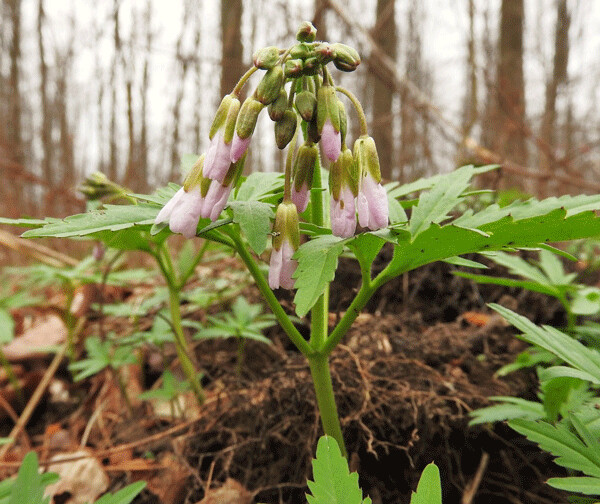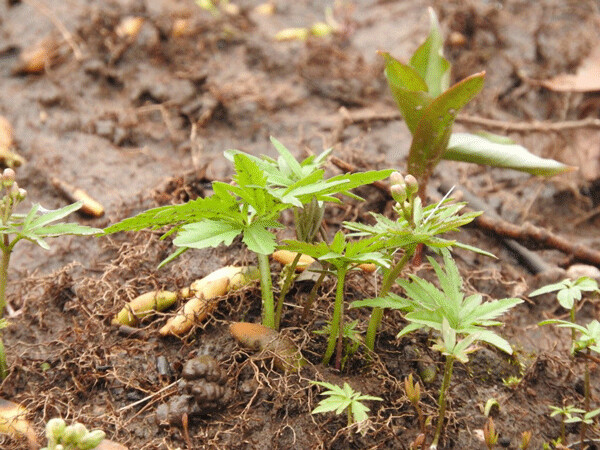News & Articles
Browse all content by date.

On one of those damp, gray days in early April, I joined the North County Trail Navigators to hike a brand new section of trail east of Copper Falls State Park, near Mellen, WI.
Light was low, but our spirits were high. Many of these women completed the 100-mile challenge on the North Country Trail (NCT) for the National Park Service’s birthday last year. Now they’re addicted, and are trying to hike this year’s miles before the mosquitoes hatch.
From the gravel road where we parked, the trail snaked its way through a beautiful sugar maple forest. The rich soil, typical of maple forests, was soft and loamy. Great for plants, but not for hiking boots. We giggled, whooped, and exclaimed as we slipped and slid through mushy spots. With use, the soil will compact and become a more durable tread, but ours were some of the first boots to travel here.
I was at the end of the line, chatting away, when I heard my name called up ahead. One of the women had spotted a mystery near the trail. In several patches, each about the size of a manhole cover, the thick maple leaf duff was pushed away. Laying exposed on the black soil were scattered chains of yellow-green plant roots that reminded me of the little plastic pop-together necklaces I won at carnivals as a kid. Each segment of the rhizome was an oval-shaped “bead.” Also visible were the lacy network of regular, thin roots.
Of course, with a naturalist along, the group wanted an explanation of what we’d found. I pulled out my camera to photograph the creeping rootstocks, but couldn’t put a name on the discovery. A few tiny clusters of curled-up leaves sprouted from the ends of the segments, but they weren’t big enough for a confident identification. All I could do for the ladies was list of a few possibilities: blue cohosh, trout lily, spring beauty, trillium, Dutchman’s breeches, wood anemone…the list of possibilities was long.

One thing that I was certain of was that these roots belonged to a spring ephemeral. This category of flowers completes their entire life cycle in the two months or so between snow-melt and leaf-out. Instead of adapting to grow in the oppressive shade of the summer forest canopy, these little plants take advantage of the full sunshine of early spring.
During their brief growing season, spring ephemerals bury an energy reserve in tuberous roots, modified underground stems, or bulbs. Those storage units lay dormant—and protected from drought or cold—through the winter. Come spring, leaves and flowers erupt quickly with the plentiful moisture and sunshine, provide food for early pollinating insects, and then restock their provisions before melting away under the deepening summer shade.
Because so many of the spring flowers that inhabit maple forests have similar strategies, the roots we found could potentially belong to any number of the sweet and beloved blooms that grace each spring. To me, this was the most interesting part of the mystery. I did, of course, do some research at home to try and match these particular roots with a name. It’s hard to find good, identifiable photos of roots, though. Happily, the challenge just meant that in order to solve the mystery with confidence, I would have to return to this beautiful trail once the leaves had expanded.

My chance came two weeks later. The trail was only slightly dryer, but the scenery had gone through a delightful change. Little green leaves pushed up everywhere, but mostly they sprouted out of the trail itself, where dark soil had warmed more quickly than the pale duff. Trout lilies, trilliums, leeks, oh my! And then I noticed a small patch of those mysterious, yellow-green segmented roots. Erupting out of their tips were the tiny palm tree-like leaves and clustered flower buds of cut-leaved toothwort. Mystery solved.
Cut-leaved toothwort (Dentaria laciniata or Cardamine concatenate) is a widespread spring ephemeral in the mustard family. Its common name describes both the narrow, toothy leaves, and also the canine tooth-shaped sections of it rhizomes. Its elongate cluster of pretty white flowers will each have four petals. True to its family, the leaves and the rhizomes of toothwort have a spicy taste, similar to wasabi. The flavor probably deters some herbivores, but it’s actually encouraged people to use it as a condiment and a medicine over the years. I chewed on a leaf, and it tasted like a very plain mustard.
One herbivore that isn’t deterred is the caterpillar of the West Virginia White, a Wisconsin State Special Concern butterfly. The butterfly lays eggs on a few species of native toothworts, and the caterpillars must grow up before their short-lived food plants senesce for the summer. In an unfortunate twist, the non-native, invasive garlic mustard shares chemical cues that attract egg-laying butterflies, but it provides inadequate nutrition for the caterpillars.
In any case, it was fun to identify friends along the trail as we all race to make the most of spring.
Special Request: If you enjoy Emily's book, Natural Connections: Exploring Northwoods Nature through Science and Your Senses, and think it should be available for more people to read, then take a moment and request it at your local library and bookstore! Order your copy at http://cablemuseum.org/natural-connections-book/. Listen to the podcast at www.cablemusum.org!
For 50 years, the Cable Natural History Museum has served to connect you to the Northwoods. Come visit us in Cable, WI! Our new exhibit: "Better Together--Celebrating a Natural Community" is now open!
| Tweet |


